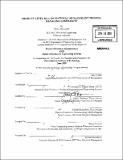Product-level bill of material development process : managing complexity
Author(s)
Lester, Ryan John
DownloadFull printable version (52.02Mb)
Alternative title
Product-level BOM development process : managing complexity
Other Contributors
Leaders for Manufacturing Program.
Advisor
Christopher L. Magee and Sara L. Beckman.
Terms of use
Metadata
Show full item recordAbstract
Cisco's current process for developing and maintaining product-level bills of materials (BOMs) has resulted in inconsistencies in BOM structure leading to product launch delays, increased product support costs, and lower customer satisfaction. Furthermore the complexity of having a large number of different, in effect customized, product solutions for its customers makes it difficult for Cisco's supply chain operations group to drive standardized methods across the over 50 business units. For Cisco's supply chain to operate most efficiently, all Cisco Business Units (BUs) must accurately structure and manage their product-level BOMs. The purpose of this thesis research is to document the as-is BOM structuring and management process, assess the issues inherent with the process today, and develop a new process that will drive standardization across the company and address the inconsistencies in BOM structure that are seen in Cisco today. The thesis work will be divided into three major sections; measure, analyze and improve. First, we will examine four business units (BUs) within Cisco Systems, Inc., which represent the varying complexities of their overall business segments. These example BUs will be studied to look at the impact of the current non-standardized process for developing the product-level BOM structure. Secondly, we will analyze this current process and show its impact on the overall enterprise, focusing on the key stakeholders involved with BOM development. (cont.) Finally, with these research findings, we will develop a new product-level BOM development methodology. This new methodology will be a criteria-based approach utilizing workflows to organize the process. The new process developed will become the foundation for continuous improvement in BOM development at Cisco Systems, Inc.
Description
Thesis (M.B.A.)--Massachusetts Institute of Technology, Sloan School of Management; and, (S.M.)--Massachusetts Institute of Technology, Engineering Systems Division; in conjunction with the Leaders for Manufacturing Program at MIT, 2009. Includes bibliographical references (p. 77).
Date issued
2009Department
Leaders for Manufacturing Program at MIT; Massachusetts Institute of Technology. Engineering Systems Division; Sloan School of ManagementPublisher
Massachusetts Institute of Technology
Keywords
Sloan School of Management., Engineering Systems Division., Leaders for Manufacturing Program.